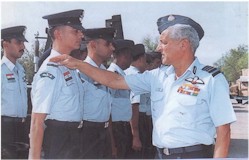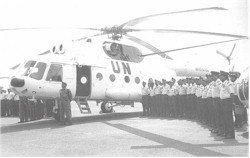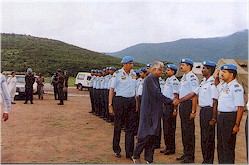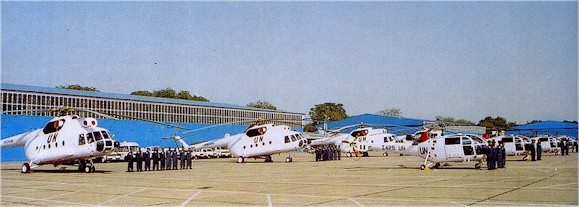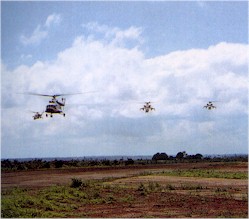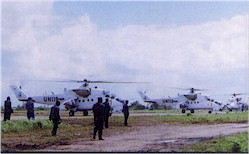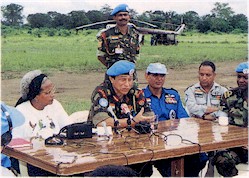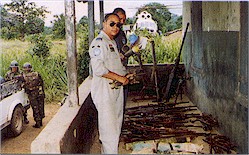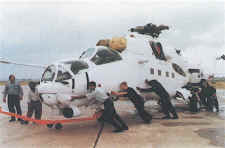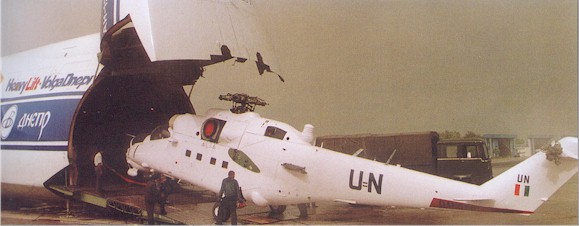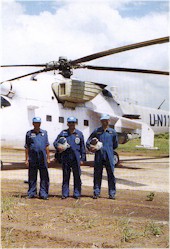One of the first IAF assignments of the new millenium was the peace keeping mission at Sierra Leone. The IAF flew offensive missions in a UN Task force for the first time since Congo.
India has a long and distinguished history in UN peacekeeping, participating in most major peacekeeping exercises since the Korean conflict in 1950. As of August 2000, India is the largest contributor to UN peacekeeping efforts with 4238 soldiers and civilian police participating in various UN peacekeeping operations around the world.
The largest deployment of Indian peacekeepers is in Africa in Sierra Leone where over 3000 Indian troops form the backbone of the UN Assistance Mission in Sierra Leone (UNAMSIL). India has no strategic interest in Sierra Leone. The presence of these Indian peacekeepers is thus a reflection of India?s historical ties with Africa and our commitment to assist any process or initiatives that are aimed to bring peace and development to the continent.
The Indian presence in Sierra Leone consists of Infantry troops, special forces, logistic and engineering groups, force headquarter personnel, as well as a fully functioning and independent aviation unit.
ROLE
The role of IAF Contingent 2000 is determined by the mandate given to UNAMSIL.The rules of engagement stress that the helicopters may fire only in self-defence or to provide protection for UN troops or personnel in the carrying out of the mandate of UNAMSIL. The IAF Contingent was under the command of Group Captain B S Siwach, and consisted of 22 Pilots, 3 Technical Officers and One officer each for Administration, logistics, Medical and Meterology. The initial fleet of 4 Mil Mi-8 and 4 Alloutte III helicopters were to be supported by a ground support team of 119 technicians.
ACTIVITY
From day 1, IAF Contingent 2000 made its presence felt and carried out invaluable service in the form of casualty, evacuation, medical, armed rescue , communication and logistic support besides gaining the goodwill of the peacekeepers of different nations. IAF Contingent took active part in welfare activities by looking after the sick and wounded of the local population and earned goodwill of the local population.
Rescue Operation ? Makeni.
07 May 2000, the contingent was tasked to evacuate three Kenyan battle casualties and 11 UN Military observers from the besieged garrison of Makeni, a major town in the north east of Free Town at a distance of about 150 kms.Immediately after landing at Makeni helipad, the helicopter piloted by Sqn Ldr TA Dayasagar and Flt Lt MK Yadav, encountered heavy firing from the RUF rebel positions around the helipad. Sqn Ldr TA Dayasagar, undeterred by the firing, offloaded the supplies and helped the casualties and the terror stricken Military Observers in the helicopter and took off with the rebels still firing at the helicopter. As soon as the helicopter was airborne, it developed very heavy vibrations as a result of damage caused by enemy firing and almost became uncontrollable.
At this point of time, the helicopter was flying over populated and forested areas with no force landing field in sight. Sqn Ldr TA Dayasagar, using his exceptional skill continued to fly the crippled helicopter for almost 10 Km before putting it down on the first available clear patch. The emergency May Day Call of Sqn Ldr TA Dayasagar was picked by another helicopter on similar mission, piloted by Wg Cdr RK Negi, who immediately headed for the force-landing site. Wg Cdr RK Negi soon landed his helicopter next to the crippled helicopter and quickly shifted all the casualties and military observers to his helicopter. During this period, the rebels were seen approaching the helicopters from all directions. Under the developing precarious situation due to imminent threat of rebel attack, Wg Cdr RK Negi, perforce, had to take the decision to abandon the crippled helicopter and subsequently rescued the crew, casualties and the military observers safely to Hastings. This daring and well co-ordinated rescue operation has earned wide scale appreciation including from UN HQs, New York.
Emergency Supply of Ration and Ammunition.
On 10 May 2000, an emergency call was received to supply rations and ammunition to Kenyan Battalion, which was moving from Makeni to Kabala. In the absence of any landing site in the area, the Force HQ was obviously in a predicament to reach the much-needed supplies to the Kenyan landed the supplies safely into the hands of Kenyans in the rebel dominated area. It will be relevant to mention here that the aircrew were given only approximate co-ordinates of the place of rendezvous with the Kenyan troops who were on the move and it was quite difficult to locate them in the thickly wooded terrain. Notwithstanding the numerous odds, the contingent aircrew lived up to their high professional standards and located the place without wasting time and earned the admiration of the Kenyans.
Modification to Mi-8 and Chetak for Armament Role.
IAF Contingent aircrew have always risen to the occasion and undertaken tasks beyond the scope of their mandate when dictated by extreme emergency conditions. During the crisis situation created by RUF rebel attacks on UNAMSIL positions, both Mi-8 and Chetak were modified to provide cover effectively from the air. All these modifications, innovations and challenging high risk missions were undertaken by the aircrew, at a time when the UNAMSIL forces were under extreme pressure from the strong rebel attacks. It would not be out of place to mention here that the fire support provided from the helicopters created panic among the rebels and at the same time boosted the morale of our forces, which finally blunted the rebel?s offensive. The contingent aircrew also took up another challenging task of providing aerial reconnaissance and acting as aerial platforms and mobile command posts in sensitive mission areas.
Despatch of Mi-35 Attack Helicopters:
By this time, it was becoming evident that more firepower would be needed to help support operations by the IAF contingent. Accordingly three Mi-35 Attack helicopters were shipped to Sierra Leone by An-124 Transports on 2nd June 2000.
Operation Khukri
For 75 days, the rebels had held 222 peacekeepers hostage. The situation had become precarious. The UN Force Cdr in consultation with his sector Cdr took the military option. The IAF contingent was tasked to execute the extraction with a host of restraints placed on them. This mission was brilliantly accomplished along with UNAMSIL forces which consisted largely of Indian Peacekeepers. The IAF Contingent was led by Gp Capt BS Siwach AVSM VM on 15 & 16 Jul 2000.
During the operation, the IAF Contingent flew a total of 98 sorties utilising 66:05 hrs. A total of 08 helicopters were utilised for this mission. The IAF assets employed for the operation were as follows :-
(a) 3 X MI-35 Gun Ships
(b) 3 X MI-8
(c) 2 X Alouettes
The mission was executed under extreme adverse weather conditions. The MI-35 gunships led by Wg Cdr AT Samtani provided accurate suppressive fire power which broke the back bone of RUF resistance. This enabled the MI-8 helicopters led by Wg Cdr RK Negi to make an ingress and outmanoeuvre the rebels by inducting and re-deploying the troops. The DZ in the mountainous terrain was encircled with RUF troops, not withstanding this the MI-8 helicopters carried out a quick ingress and egress with the stranded troops on board. The Chetaks as an aerial platform led by Sqn Ldr Gab Babu were utilised as mobile command posts directing fire and co-ordinating MI-35 and MI-8 helicopters on targets and DZ with accuracy. Throughout the operation, IAF Contingent drew heavy fire. The Chetaks were also instrumental during the operation in cas-evac of two Army casualties. The whole operation was well conceived, co-ordinated and executed with surgical precision.
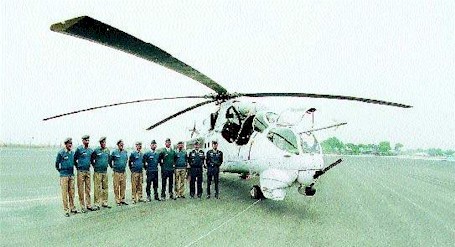 |
|
| A Three member crew of a Mi-35 pose by their aircraft at Sierra Leone | THE HEROES RETURN: India pulled out its contingent soon after Op Khukri. Seen here is the Mi-35 Dett on its return at Delhi |
CONCLUSION
The IAF played a pivotal role in enabling UNAMSIL to achieve its Mission with bare minimum casualties on the ground. Force Commander, UN HQ at New York and the world at large lauded the role played by IAF.
AWARDS AND HONORS TO THE IAF CONTINGENT IN UNAMSIL
Yudh Seva Medal (YSM)
Group Captain Bijender Singh Siwach , CO, IAF Contingent
Vayu Sena Medal (VM) (For Gallantry)
Wing Commander Rakesh Kumar Negi – Mi-8 Dett CO for Op Khukri
Wing Commander Arun Tilluy Samtani – Mi-35 Dett CO for Op Khukri
Squadron Leader George Thomas
Squadron Leader Dharmender Singh
Flight Lt Pranay Dixit
Mentioned -in- Despatches
Sqn Ldr MS Chaudhary
Flt Lt SS Gill
Warrant Officer SMS Arul
Warrant Officer GT Pandian
Warrant Officer RE Singh
Sergeant R Tupati
Sergeant S Chonut
Acknowledgements
Official Indian Armed Forces Site at http://armedforces.nic.in . Sainik Samachar publications , IAF Journal 2000 and Vayu 2000 Aerospace Review for the Mi-35 Photographs.
